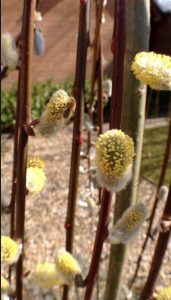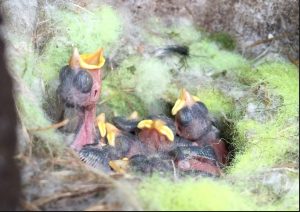Kilmarnock willow, the bird’s nest material provider!
To save birds valuable time searching for nesting material, besides nest boxes I also provide various nesting materials for them. I came across some sheep’s wool whilst walking in the countryside, attached to a length barbed wire. I wanted to see which birds would use it and put it on a Kilmarnock weeping willow tree to watch.

Kilmarnock willow such a handy tree for smaller gardens
Being a goat/pussy willow species, the Kilmarnock willow (Salix caprea Pendula) is a valuable early forage provider for solitary bees (film) and bumblebees (film). Blue tits also feed on the open flowers, an early and welcome source of food for them. With its weeping pendulous branches, it does resemble an upturned mop head. Don’t let that fool you though, it is a beautiful small tree that can be planted in larger pots. With its early catkins, then bright yellow flowers bursting open heralding the arrival of spring before the leaves open. It is ideal for the smaller wildlife garden. Birds hunt for food amongst its leaves as do many predatory wasps. It is a male clone and the female clone is known as “Weeping Sally”.
These birds really helped to make my day with their antics in removing the wool which I later found inside a Blue tit nest box. I used to provide nesting material inside the nest boxes themselves. However, the females always removed it and replaced it with their own choice of material! So provide it as I have done here or put some wool, cut it up into smaller pieces and place it inside a bird feeder which would allow them to tease it out easily. Or make mounds of different natural materials in your garden, such as short pieces of grass, hay, moss, lichen, straw, leaves, wool, feathers, mud, cotton wool, horse hair, pet hair and of course human hair. Although I have supplied all of mine over the years and now have none left!!

The female Blue tit used the brightness of ‘optic yellow’ from a neighbours tennis ball!
I did have a female Blue tit who used the bright ‘optic yellow’ felt-like material she took from a tennis ball to ‘decorate’ her nest!
For more info about nesting garden birds
FAQ about nest boxes British Trust for Ornithology
RSPB 5 ways to help nesting birds
Interested in garden birds? See BTO Garden BirdWatch

Recent Comments